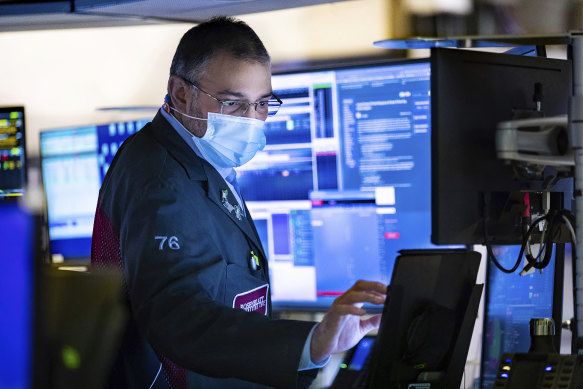ASX ticks up, defying Wall Street’s rate hike jitters
By Stan Choe and Millie Muroi
The Australian sharemarket bounced up on Thursday despite further losses overnight on Wall Street, where investors brace for interest rates to stay higher for longer.
The S&P/ASX 200 was up 21.2 points, or 0.3 per cent, to 7,272.8 at the open, buoyed by the energy and materials sectors.

Woodside (up 1.9 per cent) and coal miner Whitehaven (up 4 per cent) bolstered the index, as the energy sector more broadly climbed 1.4 per cent. Materials added 1.7 per cent, led by South32 (up 4 per cent) and mining heavyweights Rio Tinto (up 3.1 per cent), BHP (up 2.6 per cent) and Fortescue (up 2.4 per cent).
Consumer staples (down 1.6 per cent) weighed on the bourse though, as supermarket giant Woolworths shed 1.5 per cent. Lithium companies Allkem (down 3 per cent) and Pilbara Minerals (down 2.4 per cent) also dropped.
On Wall Street, most stocks marched lower as stubbornly sticky inflation has investors bracing for interest rates to stay higher for longer.
The S&P 500 fell 0.5 per cent in its first trading after coming off a frigid February. The Dow Jones Industrial Average edged up less than 0.1 per cent, while the Nasdaq composite fell 0.7 per cent.
After a hot start to the year, the stock market has struggled as data piled up to show inflation and the overall economy are remaining more resilient than expected. That forced many investors to delay their forecasts for a recession to later in the year, while also raising their expectations for how high the Federal Reserve will take interest rates.
Higher rates can drive down inflation, but they hurt the economy by making borrowing more expensive and raise the risk of a recession later on. They also drag down on prices for stocks and other investments.
Wall Street got another reminder of inflation’s stubbornness from the latest report to show that US manufacturing is weakening. A report from the Institute for Supply Management said that a measure of prices paid rose in February and hit its highest level since September.
“The biggest risk to markets is an economy that stagnates yet continues to struggle with nagging inflation pressures,” said Jeffrey Roach, chief economist for LPL Financial, in a note to investors.
‘The biggest risk to markets is an economy that stagnates yet continues to struggle with nagging inflation pressures.’
Jeffrey Roach, chief economist for LPL Financial
The market’s expectations have firmed for the Fed to stay aggressive in order to ensure inflation falls toward its 2 per cent goal. Traders have pulled back bets that the central bank could cut rates later this year, and some have increased bets it may re-accelerate the pace of its hikes later this month.
The widespread expectation is now for the Fed to take its key overnight rate to at least 5.25 per cent by June. Some bets are also calling for the rate to top 5.50 per cent, its highest level since 2001. The rate is currently in a range of 4.50 per cent to 4.75 per cent after starting last year at basically zero.
Treasury yields rose immediately after the release of the manufacturing data. They had shot higher in February as expectations rose for the Fed and rates.
Several big-name retailers have already offered discouraging forecasts for the upcoming year given the challenges US households are facing because of high inflation and other factors. Kohl’s fell 1.9 per cent after it joined them, and also said it swung to a surprise loss for the three months through January.
Vaccine maker Novavax tumbled 25.9 per cent after it warned there’s “substantial doubt” about its ability to stay in business over the next year as it had taken too long to bring its COVID jab to market, losing out to rivals Pfizer and Astra Zeneca. It reported a net loss of $US657.9 million ($973 million) for the last year.
Stock markets overseas were strong following some encouraging data on the world’s second-largest economy.
Hong Kong’s Hang Seng index jumped 4.2 per cent and stocks in Shanghai gained 1 per cent after reports on manufacturing in China showed a strong recovery after anti-virus controls were lifted late last year. That followed a slump in activity that dragged last year’s economic growth to 3 per cent, China’s second-lowest level since at least the 1970s.
In the bond market, the yield on the 10-year US Treasury rose to 3.99 per cent from 3.93 per cent late Tuesday. It helps set rates for mortgages and other loans that shape the economy, and it’s near its highest level since November after topping 4 per cent earlier in the day.
The two-year yield, which moves more on expectations for the Fed, rose to 4.89 per cent from 4.82 per cent.
with AP
The Market Recap newsletter is a wrap of the day’s trading. Get it each weekday afternoon.
Most Viewed in Business
Source: Thanks smh.com